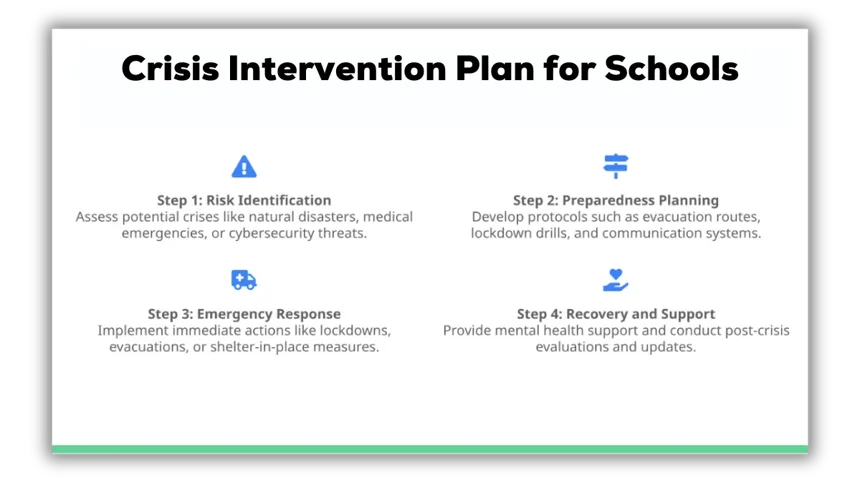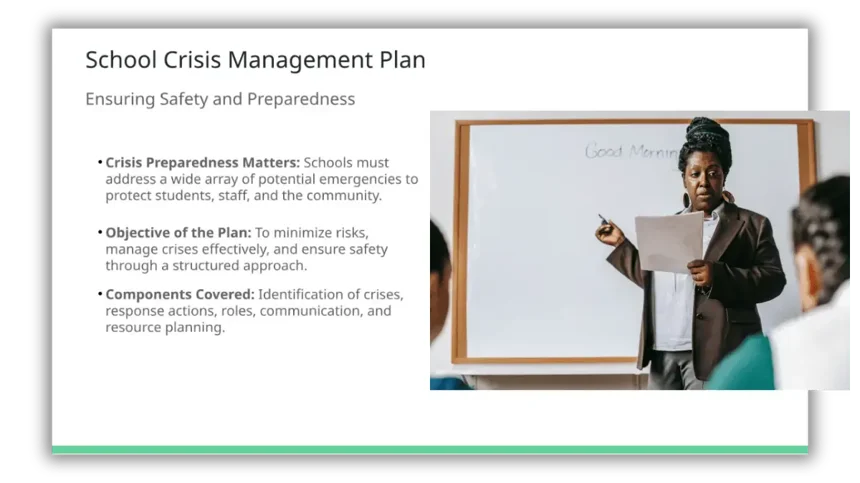Schools are built for learning and growth. But when a crisis hits, that environment can change fast.
A Crisis Intervention Plan helps schools stay calm, organized, and focused when emergencies happen.
This guide shows how to create a plan that protects students, staff, and your school’s reputation.
Key takeaways
Clear communication prevents confusion.
Preparation builds trust and confidence.
Mental health support matters as much as physical safety.
Post-crisis reviews make every plan stronger.

Communication Strategies
In any emergency, communication comes first. The faster and clearer your messages are, the safer everyone feels.
Build a Communication Chain
Decide who talks to whom before an emergency happens. Teachers report to the principal. The principal alerts the crisis team. The crisis team informs families and staff. Everyone should know their role.
Use Multiple Channels
Don’t rely on one system. Use text alerts, email, and school apps to keep parents and staff informed in real time. Accuracy and speed build trust.
Prepare Message Templates
Have pre-written messages ready to go. You can tweak them for weather warnings, lockdowns, or health alerts.
Stay Transparent
Share what you know and what you’re doing about it. Even if details are limited, honesty builds credibility. Transparency during a crisis helps protect your image. For guidance, see reputational risk management.
Crisis Plan Development
Think of your crisis plan as a roadmap. It outlines what to do when the unexpected happens.
Identify Risks
Every school faces different threats including natural disasters, accidents, and security incidents. Start by listing them.
Define Clear Goals
The goal is simple. Protect lives, reduce harm, and return to normal quickly.
Write Step-by-Step Protocols
Spell out what happens in each type of emergency. Who calls 911. Who locks doors. Where students go.
When people know their role, panic drops.
Work With Experts
Don’t do this alone. Partner with local law enforcement, fire departments, healthcare providers, and mental health professionals. Their advice makes your plan stronger.
For more guidance on preparing public responses, review proactive planning for crisis intervention.
Crisis Response Team
Your Crisis Response Team (CRT) is the command center during emergencies.
Choose the Right Members
Include the principal, school counselor, nurse, and local first responders.
Give each person clear duties.
Appoint a Leader
One person should direct operations and make decisions fast.
Assign Roles
One handles communication.
One ensures student safety.
One manages logistics like supplies and transport.
Meet Regularly
Review your plan every few months. Talk through updates and lessons from drills.
Training and Drills
Training saves lives.
Everyone including teachers, staff, and students should know what to do in an emergency.
Hold regular practice sessions. Review lockdowns, evacuations, and shelter-in-place steps until they feel familiar.
For students, keep it age-appropriate and positive. Make sure they understand that drills keep them safe.
After each drill, collect feedback. What worked. What didn’t. Adjust your plan so it improves every time.
For help maintaining positive communication after an incident, see how to repair your online reputation.
Mental Health Support
A crisis doesn’t end when the danger passes.
Emotional recovery is just as important.
Almost one in five students experience mental health challenges each year, and many don’t receive the help they need.
Schools can change that.
Build a Support System
Have trained counselors and mental health professionals ready to help students and staff.
Provide safe spaces for people to talk and process what happened.
Offer Immediate Care
Offer on-site counseling as soon as possible after an incident. Early support reduces trauma and promotes healing.
Involve Parents
Work with parents so they can recognize signs of stress or anxiety in their children. Share resources and guidance.
Teach Resilience
Hold workshops or short classroom sessions about coping skills and stress management.
When people feel prepared to handle tough emotions, your whole school community grows stronger.
If digital stress or online harassment becomes part of the crisis, review reporting internet blackmail and protecting your personal information.
For additional support, visit National Alliance on Mental Illness (NAMI) and Mental Health America (MHA).

Post-Crisis Evaluation
After any crisis, take time to reflect.
The Crisis Response Team should meet to review what worked and what didn’t.
Gather feedback from teachers, students, and parents. They see things leadership might miss.
Update the plan based on what you learn. Each revision makes the next response faster and smarter.
Keep detailed records of what happened and what actions were taken. Documentation helps both safety planning and accountability.
If public information spreads online, act quickly. Learn how to delete content from the internet or remove information from DuckDuckGo.
Protecting Your School’s Reputation
A good crisis plan protects more than people. It protects trust.
Transparent communication, empathy, and quick action show families that their children are in safe hands.
If your school needs help creating or improving its crisis plan, NewReputation can help.
Our team specializes in reputation management services, crisis communication, and proactive planning for schools and organizations.
Learn more at NewReputation.
Final Thoughts
A strong Crisis Intervention Plan saves lives, calms fears, and keeps communities together.
By focusing on communication, training, and emotional support, schools can handle any emergency with confidence and compassion.
Preparation is not just safety. It is leadership.

